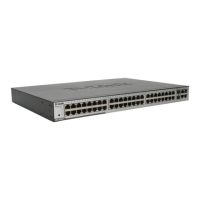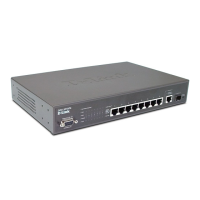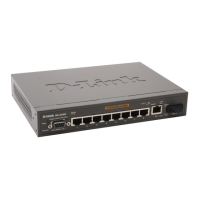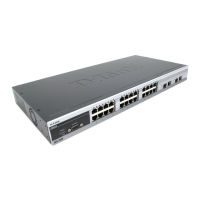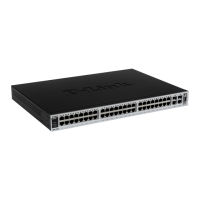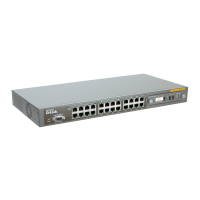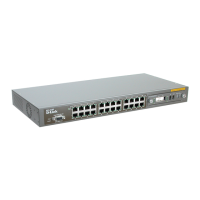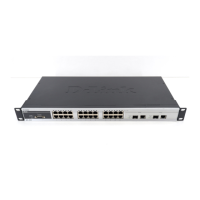Do you have a question about the D-Link DES-3052P and is the answer not in the manual?
Provides an overview of the manual's structure and intended audience.
Identifies the target audience for this user manual.
Explains formatting conventions used throughout the document.
Defines the meaning of NOTE, NOTICE, and CAUTION indicators.
Outlines essential guidelines to ensure user safety and protect equipment.
Provides safety guidelines specifically for installing the switch in a rack.
Explains methods to prevent static damage to sensitive electronic components.
Introduces the switch, its features, and hardware components.
Lists the key features and standards supported by the switch.
Describes the different types of ports available on the switch models.
Details the components visible on the front panel of the switch.
Explains the function and status indicated by each LED on the switch.
Guides on how to install Small Form-Factor Pluggable (SFP) ports.
Covers the entire installation process for the switch.
Lists all items included in the switch package for initial setup.
Provides guidelines for selecting an appropriate installation site for the switch.
Explains how to install the switch on a desktop or shelf.
Guides on mounting the switch into a standard 19-inch rack.
Provides detailed steps for rack mounting, including stabilizer usage.
Details the procedure for powering on the switch using AC power.
Offers precautions to take in case of a power failure.
Covers the physical connection process of the switch to the network.
Explains how to connect the switch to individual end devices like PCs.
Details how to connect the switch to hubs or other switches.
Introduces basic switch management methods and features.
Outlines the different methods available for managing the switch.
Details how to access and use the web interface for switch management.
Explains how to manage the switch using the Simple Network Management Protocol.
Guides on connecting to the switch via the console port for management.
Provides steps for the initial connection and login process.
Explains how to set up and manage user passwords for security.
Details the configuration of SNMP versions, community strings, and traps.
Covers methods for assigning an IP address for network management.
Explains the process of configuring the switch using its web interface.
Introduces the switch's embedded web-based interface and its capabilities.
Guides the user on how to access the switch's web management interface.
Describes the layout and areas of the web-based user interface.
Lists and describes the main folders and their contents within the web interface.
Details various administrative tasks for configuring and managing the switch.
Shows important device details like MAC address, firmware version, and system status.
Covers the configuration of port settings, including speed, duplex, and flow control.
Displays ports that have been disabled due to errors like STP loopback.
Allows users to assign descriptive names to specific switch ports.
Explains the configuration of DHCP/BOOTP relay services for network address assignment.
Details how to create and manage user accounts for switch access and privileges.
Describes how to configure port mirroring for network monitoring and troubleshooting.
Covers the configuration of sending system log messages to designated servers.
Explains how to configure the logging mode and time intervals for log entries.
Details the configuration of Simple Network Time Protocol (SNTP) for time synchronization.
Allows setting the time zone and Daylight Saving Time configurations.
Covers settings for monitoring and notifying about learned MAC addresses.
Explains the use of TFTP for firmware upgrades and configuration file transfers.
Covers managing firmware images for the switch.
Describes how to perform a ping test to verify network connectivity.
Explains the Safeguard Engine feature for mitigating network attacks like packet flooding.
Details the configuration and use of SNMP for network management.
Covers the configuration of Power over Ethernet (PoE) features.
Explains the Single IP Management (SIM) feature for managing multiple switches.
Describes the topology view within the SIM group for visualizing network connections.
Explains functions accessible via right-clicking on devices in the topology view.
Details the options available in the Single IP Management menu bar.
Guides on upgrading the switch firmware.
Explains how to back up and restore switch configurations.
Describes how to upload log files from member switches.
Covers configuring traffic forwarding and filtering rules.
Details how to configure static unicast forwarding entries.
Explains how to set up static multicast forwarding tables.
Covers the configuration of multicast filtering modes for ports.
Explains how to configure the switch to send email notifications for events.
Discusses Layer 2 networking features of the switch.
Explains Virtual Local Area Networks (VLANs) and their configuration.
Covers port trunking and link aggregation for increased bandwidth.
Details the configuration and operation of IGMP Snooping for multicast traffic.
Discusses Quality of Service (CoS) features for traffic prioritization.
Explains how to control and limit bandwidth for specific ports.
Covers assigning a default 802.1p priority to switch ports.
Explains how to assign classes of service to 802.1p priorities.
Details scheduling mechanisms for managing priority queues.
Explains how to customize output scheduling for hardware classes of service.
Covers configuring priority settings for various traffic types.
Explains how to prioritize traffic based on the TOS/DSCP field in IP headers.
Details prioritizing traffic based on DSCP values.
Covers mapping port priorities to CoS queues.
Explains how to classify packets based on MAC priority.
Discusses Access Control List (ACL) functionalities for network traffic management.
Allows defining time periods for Access Profile activation.
Covers creating and managing access profiles based on packet criteria.
Explains the feature for filtering packets destined for the switch's CPU.
Details various security features to protect the network and switch.
Covers settings for controlling network traffic and preventing storms.
Explains how to secure ports by locking MAC addresses and controlling access.
Details managing entries in the port security table.
Covers Secure Sockets Layer (SSL) configuration for secure communication.
Explains Secure Shell (SSH) configuration for secure remote access.
Details 802.1x port-based and MAC-based access control for user authentication.
Covers the configuration and limitations of Guest VLANs for limited network access.
Covers the configuration of 802.1x authenticator settings per port.
Explains how to configure local user accounts for switch access.
Details the configuration of RADIUS servers for centralized authentication.
Covers configuring trusted IP addresses for remote management access.
Explains authentication policies and parameter settings for user access.
Describes how to limit traffic flow between ports for network segmentation.
Describes how to monitor system performance, utilization, packets, and logs.
Shows the CPU usage percentage and trends of the switch.
Displays the bandwidth utilization statistics for each port.
Covers viewing packet statistics, including received, transmitted, and by type.
Covers viewing received packet statistics as a graph or table.
Details the monitoring of various packet error types on switch ports.
Allows viewing the switch's MAC address forwarding table.
Explains how to view the switch's history log for system events.
Displays information about IGMP snooping groups and their status.
Shows ports configured as router ports on the switch.
Covers viewing and managing static Address Resolution Protocol (ARP) entries.
Displays details about current configuration sessions on the switch.
Covers monitoring 802.1x statistics and related access control features.
Provides diagnostic information on the authenticator's operation per port.
Covers options for resetting the switch configuration to factory defaults.
Details the procedure for restarting the switch, with options to save settings.
Explains how to save configuration changes to NV-RAM for permanent retention.
Describes how to exit the switch management session.
Lists the detailed technical specifications for the switch hardware.
Provides general specifications including protocols, standards, and data transfer rates.
Contains information regarding product warranty and registration.
Outlines the terms and conditions of the D-Link limited hardware and software warranty.
Provides contact information for technical support in various regions.
Lists contact details for technical support in Australia.
Provides an overview of the manual's structure and intended audience.
Identifies the target audience for this user manual.
Explains formatting conventions used throughout the document.
Defines the meaning of NOTE, NOTICE, and CAUTION indicators.
Outlines essential guidelines to ensure user safety and protect equipment.
Provides safety guidelines specifically for installing the switch in a rack.
Explains methods to prevent static damage to sensitive electronic components.
Introduces the switch, its features, and hardware components.
Lists the key features and standards supported by the switch.
Describes the different types of ports available on the switch models.
Details the components visible on the front panel of the switch.
Explains the function and status indicated by each LED on the switch.
Guides on how to install Small Form-Factor Pluggable (SFP) ports.
Covers the entire installation process for the switch.
Lists all items included in the switch package for initial setup.
Provides guidelines for selecting an appropriate installation site for the switch.
Explains how to install the switch on a desktop or shelf.
Guides on mounting the switch into a standard 19-inch rack.
Provides detailed steps for rack mounting, including stabilizer usage.
Details the procedure for powering on the switch using AC power.
Offers precautions to take in case of a power failure.
Covers the physical connection process of the switch to the network.
Explains how to connect the switch to individual end devices like PCs.
Details how to connect the switch to hubs or other switches.
Introduces basic switch management methods and features.
Outlines the different methods available for managing the switch.
Details how to access and use the web interface for switch management.
Explains how to manage the switch using the Simple Network Management Protocol.
Guides on connecting to the switch via the console port for management.
Provides steps for the initial connection and login process.
Explains how to set up and manage user passwords for security.
Details the configuration of SNMP versions, community strings, and traps.
Covers methods for assigning an IP address for network management.
Explains the process of configuring the switch using its web interface.
Introduces the switch's embedded web-based interface and its capabilities.
Guides the user on how to access the switch's web management interface.
Describes the layout and areas of the web-based user interface.
Lists and describes the main folders and their contents within the web interface.
Details various administrative tasks for configuring and managing the switch.
Shows important device details like MAC address, firmware version, and system status.
Covers the configuration of port settings, including speed, duplex, and flow control.
Displays ports that have been disabled due to errors like STP loopback.
Allows users to assign descriptive names to specific switch ports.
Explains the configuration of DHCP/BOOTP relay services for network address assignment.
Details how to create and manage user accounts for switch access and privileges.
Describes how to configure port mirroring for network monitoring and troubleshooting.
Covers the configuration of sending system log messages to designated servers.
Explains how to configure the logging mode and time intervals for log entries.
Details the configuration of Simple Network Time Protocol (SNTP) for time synchronization.
Allows setting the time zone and Daylight Saving Time configurations.
Covers settings for monitoring and notifying about learned MAC addresses.
Explains the use of TFTP for firmware upgrades and configuration file transfers.
Covers managing firmware images for the switch.
Describes how to perform a ping test to verify network connectivity.
Explains the Safeguard Engine feature for mitigating network attacks like packet flooding.
Details the configuration and use of SNMP for network management.
Covers the configuration of Power over Ethernet (PoE) features.
Explains the Single IP Management (SIM) feature for managing multiple switches.
Describes the topology view within the SIM group for visualizing network connections.
Explains functions accessible via right-clicking on devices in the topology view.
Details the options available in the Single IP Management menu bar.
Guides on upgrading the switch firmware.
Explains how to back up and restore switch configurations.
Describes how to upload log files from member switches.
Covers configuring traffic forwarding and filtering rules.
Details how to configure static unicast forwarding entries.
Explains how to set up static multicast forwarding tables.
Covers the configuration of multicast filtering modes for ports.
Explains how to configure the switch to send email notifications for events.
Discusses Layer 2 networking features of the switch.
Explains Virtual Local Area Networks (VLANs) and their configuration.
Covers port trunking and link aggregation for increased bandwidth.
Details the configuration and operation of IGMP Snooping for multicast traffic.
Discusses Quality of Service (CoS) features for traffic prioritization.
Explains how to control and limit bandwidth for specific ports.
Covers assigning a default 802.1p priority to switch ports.
Explains how to assign classes of service to 802.1p priorities.
Details scheduling mechanisms for managing priority queues.
Explains how to customize output scheduling for hardware classes of service.
Covers configuring priority settings for various traffic types.
Explains how to prioritize traffic based on the TOS/DSCP field in IP headers.
Details prioritizing traffic based on DSCP values.
Covers mapping port priorities to CoS queues.
Explains how to classify packets based on MAC priority.
Discusses Access Control List (ACL) functionalities for network traffic management.
Allows defining time periods for Access Profile activation.
Covers creating and managing access profiles based on packet criteria.
Explains the feature for filtering packets destined for the switch's CPU.
Details various security features to protect the network and switch.
Covers settings for controlling network traffic and preventing storms.
Explains how to secure ports by locking MAC addresses and controlling access.
Details managing entries in the port security table.
Covers Secure Sockets Layer (SSL) configuration for secure communication.
Explains Secure Shell (SSH) configuration for secure remote access.
Details 802.1x port-based and MAC-based access control for user authentication.
Covers the configuration and limitations of Guest VLANs for limited network access.
Covers the configuration of 802.1x authenticator settings per port.
Explains how to configure local user accounts for switch access.
Details the configuration of RADIUS servers for centralized authentication.
Covers configuring trusted IP addresses for remote management access.
Explains authentication policies and parameter settings for user access.
Describes how to limit traffic flow between ports for network segmentation.
Describes how to monitor system performance, utilization, packets, and logs.
Shows the CPU usage percentage and trends of the switch.
Displays the bandwidth utilization statistics for each port.
Covers viewing packet statistics, including received, transmitted, and by type.
Covers viewing received packet statistics as a graph or table.
Details the monitoring of various packet error types on switch ports.
Allows viewing the switch's MAC address forwarding table.
Explains how to view the switch's history log for system events.
Displays information about IGMP snooping groups and their status.
Shows ports configured as router ports on the switch.
Covers viewing and managing static Address Resolution Protocol (ARP) entries.
Displays details about current configuration sessions on the switch.
Covers monitoring 802.1x statistics and related access control features.
Provides diagnostic information on the authenticator's operation per port.
Covers options for resetting the switch configuration to factory defaults.
Details the procedure for restarting the switch, with options to save settings.
Explains how to save configuration changes to NV-RAM for permanent retention.
Describes how to exit the switch management session.
Lists the detailed technical specifications for the switch hardware.
Provides general specifications including protocols, standards, and data transfer rates.
Contains information regarding product warranty and registration.
Outlines the terms and conditions of the D-Link limited hardware and software warranty.
Provides contact information for technical support in various regions.
Lists contact details for technical support in Australia.
| PoE | Yes |
|---|---|
| PoE Budget | 370W |
| MAC Address Table | 8K entries |
| Jumbo Frame Support | Yes |
| Dimensions (W x D x H) | 440 x 44 x mm |
| Operating Temperature | 0°C to 40°C |
| Storage Temperature | -40°C to 70°C |
| Power Consumption | Max 400W |
| Input Voltage | 100 to 240 VAC, 50/60 Hz |
| Ports | 48 x 10/100 Mbps PoE ports, 4 x 10/100/1000 Mbps uplink ports |

